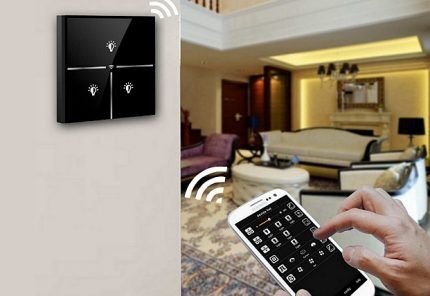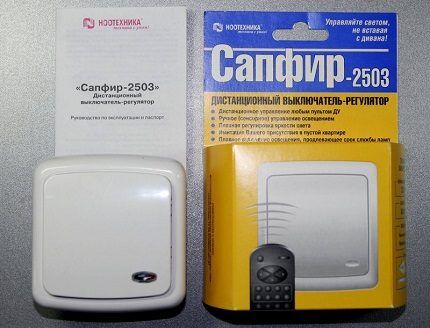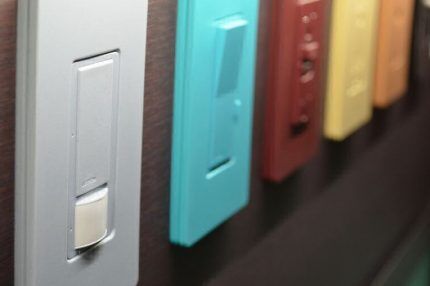Smart switches: types, markings, how to choose and connect correctly
To ensure a comfortable lifestyle, modern homes are increasingly using high-tech fixtures and appliances with a wide range of options. Such devices include smart switches that operate in automatic mode. It’s worth familiarizing yourself with the peculiarities of their work, don’t you agree?
The article we have proposed describes in detail the principle of operation and features of the use of smart switches, the operation of which is controlled remotely - using a tablet, smartphone, or computer. Advice on selection is given, and the specifics of labeling are discussed. The rating of the leading manufacturers in the segment is given.
The content of the article:
- Operating principle of a smart device
- Using smart devices
- Smart Appliances: Pros and Cons
- Types of smart units
- Interaction with other devices
- How to choose the right product?
- Labeling of smart devices
- Features of connecting switches
- Top 7 manufacturers of smart devices
- Conclusions and useful video on the topic
Operating principle of a smart device
The Wi-Fi switch kit contains two devices: a receiver and a transmitter. The first device is a miniature relay that can be controlled using a smartphone or remote control. Having detected the supplied signal, the relay closes the electrical circuit.
The device, which has a compact size, is usually installed near the lighting fixture, for example, under a suspended ceiling. The relay can also be mounted in a distribution panel or inside a luminaire.

The transmitter functions are performed by a switch, the design of which is equipped with a small electric generator. When you press a key or send a specific command from a smartphone, the device generates an electric current, which is transformed into a radio signal.
In addition to issuing a command, the device also records information confirming the execution of the order. Information can be transmitted to the controller responsible for the operation of the system, or directly to the smartphone.

A smart switch can replace or complement a traditional switch device. This allows you to maintain the usual functions of the device, namely turning the light on/off using a button or key. At the same time, it acquires “smart” options, which will be discussed below.
Using smart devices
Smart switches provide homeowners with many new options. With their help, you can adjust the light parameters in the room using your smartphone. A very convenient feature is programming devices to automatically turn on/off at a certain time.
In addition, the homeowner can check from a distance whether the lights are on in a particular room, and, if necessary, remotely turn off any of the lamps.
Another option: the mode of turning on the lighting in the room as soon as a person enters it and turning off the light when the owner or guest leaves.

An option that allows you to automatically light the lamps when it gets dark and turn them off when there is enough sunlight allows you to significantly reduce your electricity costs. Some models also provide a function for monitoring the use of electricity.
Even greater opportunities are provided by smart devices with dimmers. They are designed not only to turn on/off lighting fixtures, but also to change the level of lighting intensity.
Such smart devices allow you to change the brightness of the lamps according to a given program or taking into account data received from light and motion sensors.
Smart Appliances: Pros and Cons
Devices that can be controlled using smartphones have undeniable advantages:
- to install them, you do not need to lay a special dedicated branch of electrical wiring;
- they allow you to regulate the operation of light sources, as well as other devices, centrally from one place;
- as a control point it is possible to use smartphones, tablets, computers, as well as remote controls;
- smart devices contribute to a significant reduction in energy costs - according to calculations by American scientists, savings can reach 42%;
- the devices have a wide range of action (up to 100 meters), while the signal passes freely through various obstacles, for example, walls;
- for their operation, a weak current is sufficient, which will not harm a person even if the system is damaged.
The main disadvantage of smart switches is the need for an Internet source.

Types of smart units
Manufacturers offer a fairly wide range of smart solutions that can work on Wi-Fi, Bluetooth, ZigBee, Z-Wave.
The devices also differ in design features. Some of them are specifically designed for connection to a network in which a neutral wire is present. At the same time, phase “0” is not required for installation of many products, including most smart dimmers.
Devices with dimming function
A significant part of the models of smart devices for turning on/off lights also successfully play the role of a dimmer - a device that regulates the brightness of lighting fixtures. All options in this case are preserved: the smart device, controlled from a smartphone, can operate in automatic mode.

Additional capabilities provided by dimmers allow you to significantly expand the range of use of switches.
With their help, it is easy to create a cozy atmosphere in the room, turning on bright light only when necessary.In addition, dimmers are also widely used by interior designers as lighting control devices.
Devices with remote control
Another type of smart device is a remote switch. In appearance it resembles a traditional one, but in fact it is a remote control.

An intelligent device, like a regular switch, consists of a frame and a key. Since it does not require any electrical wiring, it can be installed almost anywhere in the room.
The function of the remote switch is to transmit commands via radio waves to other devices. It necessarily works in conjunction with other devices, for example, together with dimming switch, which, after receiving a signal, will reduce the intensity of light in the burning chandelier.
The same device can also be used to control the operation of a smart socket.
Interaction with other devices
The autonomy of a smart device depends on its design features. Wi-Fi devices can work directly from a smartphone without the use of any additional devices.

At the same time, to regulate the operation of devices operating on the ZigBee or Z-Wave protocols, an additional product is required - a controller, which acts as an intermediary between the switch and the smartphone.
The same control device is also used to store user programs, for example, information about the time of automatic switching on/off of lamps. At the right moment, the controller transmits the necessary signals to the lighting fixtures, which guarantees the execution of the specified algorithms.
With the help of modern technologies, it is possible to establish an interoperable network consisting of a number of smart devices. The consumer has the opportunity to set the switch to turn on the light based on a signal from a sensor that is triggered when the doors are opened.
In turn, turning on the lighting in the room can affect the start of operation of other household appliances, for example, an air conditioner.
How to choose the right product?
There are a number of factors to consider when choosing a smart appliance. First of all, you should consider whether there is Wi-Fi or other Internet sources in the house.
Many models are equipped with a set of additional functions, for example, compatibility with lamp with motion sensor or lighting. Such functions significantly expand the range of applications of the device, but increase its cost.

For smart devices that are planned to be placed in wet areas or outdoors, the level of protection against airborne water is important. There are also special models designed to work in difficult conditions.
If the purchased switch is planned to be placed in a socket, its design does not play a special role. It is desirable, however, that the device be sized to fit the niche allocated for it.
When purchasing a circuit breaker that is planned to be mounted on a wall, you should pay attention to its appearance: color, shape, presence of backlighting.
Product quality is of great importance. It is advisable to give preference to devices from well-known brands. If the device is purchased in a store, you should carefully inspect it. A high-quality model should have a smooth surface, clear lines, neat, easily disassembled components.
An important factor is the density of the polymer from which the device is made. Since products made of soft plastic quickly become covered with scratches and dents, it is better to choose a switch made of hard plastic, which does not lose its aesthetic appearance for a long time.

Reliable manufacturers usually offer their products complete with fasteners and latches. It is advisable that the product comes with assembly and installation instructions. The manual can be in the form of a brochure, leaflet, or simply text printed on the packaging.
Labeling of smart devices
Smart switches often have letters and numbers printed on them to indicate their characteristics. Please note that different manufacturers often use their own labeling, so the designations may not be the same.
Nevertheless, we will name a few typical options. First of all, the name of the devices may mention the control method, for example, Wi-Fi. In hybrid solutions that can be controlled using a radio signal, the designation Wi-Fi/R or Wi-Fi/RF is used.

The two-digit number located at the end of the model name - 01, 02, 03 - indicates the number of light groups that can be controlled from this device.
The device marking may also contain the following letters:
- S – with pass-through switch function;
- D – allows you to dim the lighting;
- T – the presence of a timer that allows you to turn on/off the light at a given time.
Often a pointer is also placed on the device indicating degree of protection against moisture and dust. It consists of a combination of the letters IP, followed by a two-digit number.
Its first digit in the range 0-6 indicates the level that prevents dust and foreign objects from penetrating into the product. The second, in the range of 0-8, indicates resistance to water vapor. The higher the numbers indicated, the higher the degree of protection.
The following signs are also placed on any device: I or In, meaning switching on; O or Out – turn off the device.
Features of connecting switches
The installation of smart devices depends on the type of lighting fixtures with which they will work. If the product is intended for a system where incandescent lamp, installation is carried out in the same way as connecting a traditional analogue.

For intended use LEDs or energy saving lamps For safe operation, you need to connect the device to wiring with the existing neutral and phase wires. As a rule, in such cases it is placed next to or even inside the lamps.
Switches that provide acoustic control are mounted in place of standard devices or near light sources.
All smart devices are easy to connect. They usually come with instructions, following which you can mount the device yourself, spending a minimum amount of time.
First you need to install the signal receiver. To do this, you need to break the phase, and then connect the device to the existing electrical network, aligning the wires correctly.
When installing a device that regulates the operation of a group of lamps, the procedure will be somewhat more complicated. In this case, after supplying the neutral wires to the lighting, you need to branch the phase going to the Wi-Fi device, directing each to a separate group of light sources.

After assembling the device, you must also install the appropriate application, which will be used to carry out the regulation process. This may require registering the device on the network or turning it on "Smart Home" system.
Once all operations are completed, the screen will display all available options for the connected product, as well as its current status.
Top 7 manufacturers of smart devices
Switches capable of controlling light using a smartphone are produced by many domestic and foreign companies. Let's look at just a few of them that have received user recognition.
Legrand. A reputable French company founded in the first half of the 19th century. Specializing in the production of electrical equipment, the company produces a line of Celian wireless control devices.
Delumo. A popular Russian manufacturer whose product range includes a wide range of different types of switches, thermostats and dimmers. The products are in demand due to the optimal ratio of cost and quality.

Sonoff. The company specializes in the production of wireless smart devices such as sockets, switches, and relays. All equipment is offered with Russian-language instructions, as well as with specially developed applications, also made in Russian.
Vitrum. An Italian manufacturer that produces devices based on Z-Wave technology. As a rule, such devices are used in Smart Home systems to automate light adjustment.
Xiaomi. A rapidly growing Chinese company founded in 2010. In addition to popular models of smartphones and tablets, the production facilities also produce high-tech electrical devices, including smart switches.
Noolite. A Belarusian company actively engaged in the development and sale of smart products, including dimmers, controllers, timers, switches, and protection modules. They are distinguished by reliability, ease of use, and low price.
Also worthy of attention are the budget but high-quality products of Chinese manufacturers Kopou, Broadlink, Livolo, as well as expensive products produced by the American company Lutron and the German company Jung.
Conclusions and useful video on the topic
In the presented video you can hear a detailed overview of the popular model of Wi-Fi switch manufactured by Soniff. Visual instructions for connecting this device are also provided:
Smart appliances can significantly improve the comfort level of residential premises. They are also important for providing the owners of apartments or houses. The devices will automatically turn on the lights and can scare away criminals from an empty apartment, simulating the presence of the owners.
Please leave comments in the block below, ask questions, post photos on the topic of the article. Tell us about how you chose a smart switch. Share the criteria that were decisive in determining the best model for you.




I was jealous of my neighbor because he has “smart” switches in his apartment. I asked him how much it cost, where he ordered it, and, in general, what are the disadvantages of operation. He told everything, such systems are certainly not cheap. Not every technician will handle the installation; sometimes there are failures, for example, if Wi-fi is turned off. This system also consumes more electricity than conventional switches. Given these facts, I'd rather stick with regular switches for now.
While reading the article, I remembered a story about how a friend installed similar switches for himself, but saved on everything he could. Including a decent electrician. Thanks to all this, something was connected to him incorrectly, and as a result, the apartment almost burned down. He didn’t give up the idea, but the second time he approached it more thoroughly. I hired an electrician and bought good materials. If he had read this article earlier, maybe everything would have been different.
I installed Sonoff T4 and I can name two big disadvantages of the long-awaited purchase:
1) Every morning the switch has to be turned on from the phone, every first turn on is problematic, the sensor does not react at all.
2) The LEDs on the switch panel organized stereo lighting, which I did not plan, and now I sleep in a blue room)